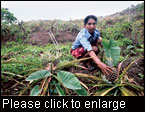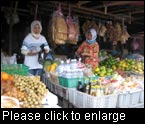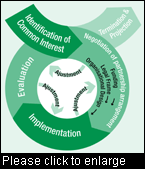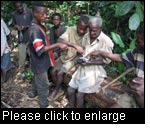InfoResources
News No 5 / 08 (December 2008)
Special feature
> Promoting women as the guarantors
of rural livelihoods
Policy
> Learning from the dragon and the
elephant
> Climate change: caring today for
tomorrow
> Donors revise their policies
regarding rural development in Africa
> LULUCF: a key to climate change
mitigation
> What’s new about
the Novel Foods Regulation? Implementation
> Public-private partnerships for
agricultural innovation
> Empowerment: taking the reins
> Pathways to sustainable production
and trade of biofuels
> Urban agriculture:
a coping strategy in Kenya Research
> Free, prior and informed consent
and sustainable forest management
Special Feature
Promoting women as the guarantors of rural
livelihoods

A number of
recent publications and initiatives have dealt with the
important issue of gendered approaches as a means of curbing
the generalised decline in food security and livelihood
opportunities, especially in rural and disadvantaged areas of
developing countries.
While rural
women and men play complementary roles with regard to food
security, women play a much more important role when it comes
to natural resource management and to ensuring nutrition.
Hence, climate change adaptation and the search for new
approaches to guarantee families’ subsistence are primarily
the result of women-led initiatives.
According to
the IFPRI report, if interventions to strengthen women’s
control of natural resources are to succeed, they must take
account of local gender norms. One area where this type of
intervention could be required is the issue of tenure of and
access to land, soil and water. In Cameroon, for example, an
irrigated rice project did not assign women land because they
were expected to work in their husbands’ fields, which they
indeed did. They then ceased growing sorghum, a crop intended
to feed their families, outside the irrigation scheme. The
project failed in one of its objectives, namely strengthening
women’s rights to land. Other areas requiring intervention
include the introduction of new crop varieties and
technologies, as well as access to training, markets and
financial services. In Bangladesh, where women risk disrepute
by working outside the home, a group of females successfully
adopted improved vegetable technologies disseminated by a
women’s NGO because they were able to grow these vegetables on
their own homestead.
The
Nicaragua-based journal Guacal dedicated a recent issue to the
battle for women’s access to land. With backing from the
women’s platform for food security and for food and
nutritional sovereignty, a demonstration was held in October
2008 to demand women’s land tenure rights. According to one
representative, “…women are unable to avail of credit because
they do not actually own the land that they cultivate”. Fierce
criticism has been levelled at a new bill – the “Law on the
creation of funds to assist land purchases based on the
principle of gender equality” – which is currently being
drafted. The women’s platform hopes that any changes to the
bill will not overlook the issue of a woman’s right to own the
land on which she works. In addition to exploring the question
of what should happen to such land titles in the event of
separation or divorce, this special issue also comments in
detail on the aforementioned draft legislation.
The third
publication examines the impact of climate change on gendered
approaches as well as the relation between the two,
particularly with regard to natural resources. Recent evidence
shows that women who have already started to feel the effects
of weather-related disasters (erratic monsoon patterns,
flooding etc.) are developing strategies which require them to
adapt their farming practices. In the Ganga river basin
(Bangladesh, India and Nepal), for example, local women have
switched to flood-resistant crops or to ones which can be
harvested before the monsoon season; they also now cultivate
other varieties of rice which grow high enough to remain above
water when the floods come.
There is a
common theme which runs through each of these three articles,
namely the importance of human and social capital, whether it
be safeguarding families’ livelihoods through investment in
education, health, and women’s nutrition, or the promotion of
women’s associations.
Sources:
> Promising Approaches to Address the Needs of Poor Female
Farmers. Agnes Quisumbing and Lauren Pandolfelli. IFPRI, 2008.
8 p.
www.ifpri.org/pubs/ib/in13.pdf
> Las mujeres demandan el acceso a la tierra. In: El Guacal,
no 4, 2008. 28p.
www.simas.org.ni/files/cidoc/GUACAL_4.pdf
> Gender and climate change: mapping the linkages:
A scoping study on knowledge and gaps. Alyson Brody, Justina
Demetriades and Emily Esplen. IDS, 2008. 27 p.
www.bridge.ids.ac.uk/reports/Climate_Change_DFID.pdf
> Targeting women pays when promoting food security. Alfred
Lakwo. LEISA Magazine, 24.3, September 2008, p. 10–11.
www.leisa.info/index.php?url=getblob.php&
o_id=214937&a_id=211&a_seq=0
> For more information on this topic (in French only): Genre,
femmes rurales et développement. Rubriques Accès à la terre et
aux ressources naturelles et Sécurité alimentaire.
www.fao.org/dimitra/ressources-par-theme/fr/

Policy
Learning from the dragon and the elephant
China’s and India’s economies have grown rapidly over the
past 25 years. Both the “dragon” and the “elephant” have
implemented comprehensive economic reforms. The fact that they
have taken very different approaches makes it all the more
interesting to explore the lessons that can be learned for the
future and for other countries.
China has invested heavily in agricultural infrastructure and
research, and has facilitated access to land. This has enabled
the country to reduce poverty substantially over a short period
of time. Food supply has improved, and rural income has risen.
In comparison, India’s policy of subsidising agricultural inputs
and food prices has been less successful. At the same time,
however, India has gained positive experiences with
decentralised and participatory approaches, which have enabled
agricultural development programmes to better target specific
poor population groups. China’s nationwide, top-down measures
failed to achieve this precision.
In future, according to the authors, both countries should
focus on enhancing the efficiency of resource use and of
administrative processes. Furthermore, efforts must be made to
promote agricultural education and social protection measures.
Due to this publication’s main focus being on poverty reduction,
the ecological consequences of economic growth remain somewhat
in the background.
Source: The Dragon and the
Elephant. Learning from Agricultural and Rural Reforms in
China and India. Ashok Gulati and Shenggen Fan. IFPRI Issue
Brief 49. July 2008. 4 p.
www.ifpri.org/pubs/ib/ib49.pdf
Climate change: caring today for tomorrow
Adaptation to climate change is a slow process that bears
many uncertainties and risks. In light of the varying
responsibility of the different countries for climate change,
on the one hand, and the varying levels of nationally
available adaptation resources, on the other, the authors
propose an international plan that foresees help for the
economically weaker countries to be provided by the
economically stronger. Moreover, the authors explain the
interlinkages that need to be considered when devising such a
plan.
One crucial factor is the definition of the term
“adaptation”: the broadness of its understanding determines
whether the focus is only on climate change, which calls for a
long-term planning horizon, or whether the goal is also to
enhance resilience to extreme weather events. Another question
that needs to be considered is whether existing development
activities are, or should be, adapted to the changing climatic
conditions. Evaluating the costs of this operation is difficult,
and results vary widely depending on the approaches and methods
used. This necessitates flexibility in planning. In addition, it
is important to clearly separate this support of adaptation
efforts from regular development cooperation in order to avoid
competition for funding.
Source: A note on including
climate change adaptation in an international scheme. Stéphane
Hallegatte. IDDRI, Idées pour le débat, N° 18/2008. 15 p.
www.iddri.org/Publications/Collections/Idees-pour-le-
debat/Id_0818_Hallegatte_adaptation.pdf
Donors revise their policies regarding rural
development in Africa
The impacts of climate change and the ongoing food crisis
have added momentum to the call for greater investments in
African agriculture. Various donor organisations, but also
African governments have already declared their intentions to
step up their commitments. This welcome change of trend raises
the major question of where and how to invest.
This report gives a brief overview of the political
priorities of the most important donors engaged in African rural
development. The authors show that discussions centre around
five main themes: aid efficiency, market contribution to growth,
the future of small-scale agriculture, improving governance, and
the increasing assumption of responsibility by Africa itself.
According to most donors, the market and the private sector
are crucial for rural development. However, the state has an
important role to play, as well: among other things, governments
should strongly increase their efforts to foster research and
the development of adapted technologies. The various donor
organisations disagree over many of the issues at stake; this is
the case also for the question of how to support small farmers.
Source: More Aid
for African Agriculture. Policy implications for small-scale
farmers. UK Food Group. 2008. 42 p.
www.ukfg.org.uk/more-aid-for-african-agriculture.php
LULUCF: a key to climate change mitigation
The fact
that greenhouse gas emissions are on the increase worldwide
is in conflict with the emission goals defined up to 2012 in
the Kyoto Protocol and the various framework treaties.
Scientists point out shortcomings in implementation, but
they also criticise the fact that agriculture and forestry
have not been adequately integrated into international
efforts: for example, both sectors have been systematically
excluded from trade in emission certificates.
Land use,
land-use change and forestry (LULUCF in short) have a great
potential for climate protection. The authors provide
comprehensive insights into the possibilities that LULUCF
offer in terms of climate change mitigation. The report
includes several suggestions for adaptation in agriculture
and forestry, as well as LULUCF-specific recommendations
regarding the post-2012 climate regime. One chapter is
dedicated exclusively to LULUCF in developing countries. A
large share of the forests in these countries are degraded
or completely destroyed. Given the importance of forests
with regard to carbon sequestration, in future more efforts
must be directed at forest restoration. Moreover, these
efforts must benefit the local populations both economically
and socially. Climate protection and development goals can
indeed be linked together in a win-win setting.
Source: Key
issues on land use, land use change and forestry (LULUCF) with
an emphasis on developing country perspectives. Carmenza
Robledo and Jürgen Blaser. Intercooperation / UNDP. September
2008. 49 p.
www.undp.org/climatechange/docs/UNDP_LULUCF.pdf
Information on the context:
www.undp.org/climatechange/documents.html
What’s new about the Novel Foods Regulation?
 The
EU Regulation on Novel Foods and Novel Food Ingredients (EC No
258/97) was adopted in 1997 with the aim of establishing
standardised rules for novel foods to ensure human health and
protect consumers. The regulation defines ‘novel’ food as a
food or ingredient that has not previously been used for human
consumption at a significant level within the EU – regardless
of whether it has been eaten safely elsewhere over centuries.
Extensive scientific data are required to prove its safety.
Since the definition of novel food includes traditional foods
from developing countries, this regulation has created
critical barriers to producers in poor countries wishing to
market their products in Europe. The
EU Regulation on Novel Foods and Novel Food Ingredients (EC No
258/97) was adopted in 1997 with the aim of establishing
standardised rules for novel foods to ensure human health and
protect consumers. The regulation defines ‘novel’ food as a
food or ingredient that has not previously been used for human
consumption at a significant level within the EU – regardless
of whether it has been eaten safely elsewhere over centuries.
Extensive scientific data are required to prove its safety.
Since the definition of novel food includes traditional foods
from developing countries, this regulation has created
critical barriers to producers in poor countries wishing to
market their products in Europe.
The regulation is now under revision with a view to finding a
more precise definition both of a product’s novelty and of how
to assess its safe use. A final regulation might be adopted next
June. There is a risk that this revision will generate
additional hurdles for producers and exporters from developing
countries. Interested parties should therefore seize the
opportunity to contribute to the revision process. Producers’
experiences in dealing with the regulation can serve as a basis
for improving the procedures for assessing information on novel
food products. International, regional and exporting
governmental institutions should mobilise stakeholders to ensure
that their interests are taken into consideration. The time to
contribute is running short, so action must be taken now!
Source: Understanding the
Revision Process of the Regulation on Novel Foods. Eduardo
Escobedo. Biodiversity and Climate Change Section, United
Nations Conference on Trade and Development (UNCTAD). 2008. 6
p.www.underutilized-species.org/Documents/PUBLICATIONS/
nfr_update_sep_2008.pdf

Implementation
Public-private partnerships for agricultural
innovation
 In
Mairana Valley, Bolivia, 250 small peanut producers, an
exporter, the local government and a provider of agricultural
extension services have joined forces. The goal of their
partnership is to improve productivity and competitiveness in
peanut production. In
Mairana Valley, Bolivia, 250 small peanut producers, an
exporter, the local government and a provider of agricultural
extension services have joined forces. The goal of their
partnership is to improve productivity and competitiveness in
peanut production.
The authors have analysed 125 public-private research
partnerships in Latin America and published their results in a
guidebook. The book gives a detailed description of the various
aspects to be considered when building partnerships for
innovation: identification of shared interests, funding schemes,
legal aspects, organisational design, implementation, and
evaluation. According to the authors, an important prerequisite
for public-private partnerships (PPPs) to be successful is the
commitment of all partners involved, along with transparency and
an atmosphere of trust between partners.
PPPs in agricultural innovation and research can have various
advantages for the different partners, for example reduced risks
and costs or increased quality and relevance of the solutions
developed. However, the PPPs must be adapted to their specific
context, and in some situations they are not the ideal solution.
Sources: Building
Public-Private Partnerships for Agricultural Innovation. Frank
Hartwich et al. International Food Policy Research Institute
(IFPRI). 2008. 95 p. www.ifpri.org/sites/default/files/publications/sp4.pdf
Empowerment: taking the reins
The main challenges for empowerment are to alleviate
poverty and to transform power relations that have led to
certain population segments having less opportunities than
others to shape their lives. More and more, it has become an
acknowledged imperative not only to understand the underlying
causes that explain why some people and groups in society are
more powerful than others, but also to discuss and implement
mechanisms and strategies that may contribute to generating
equal opportunities, building capacities, and ensuring
equitable access to resources.
In this context, in 2005 the ASOCAM Latin American Network
launched a regional process of reflection and inter-learning
among thirty development organisations from seven countries.
Resulting guidelines and products have now been made available
through a new thematic website.
The website offers reflections on concepts and approaches to
empowerment, including articles and theses by Latin American
experts. The topic is explored in its social, political and
economic dimensions, and strategies for implementation are
suggested. The website also provides indicators for monitoring
and evaluation, a complete virtual library, and links to
organisations specialising in the topic.
Source:
Empowerment Practices, Regional Specialized Website
www.empoderamiento.info
www.asocam.org/biblioteca/ASO_SIN_EN_Emp.pdf
Pathways to sustainable production and trade of biofuels
Biofuels are currently the object of much controversy.
Produced in a sustainable manner, they could contribute to
mitigating the energy crisis and slowing climate change.
However, at present they are associated more with loss of
biodiversity and with food shortage. This situation calls for
clear criteria to regulate their production and trade.
The UNCTAD publication demonstrates that certification
programmes are an option for supporting sustainable production
of, and trade in, biofuels. To achieve this goal, existing
programmes must be coordinated and criteria need to be given a
flexible wording that allows for adaptation to different
ecological and socio-economic conditions. Moreover,
certification programmes should be based on participatory
processes and linked to incentives to increase their
attractiveness.
One example of principles and criteria for sustainable
production of biofuels is provided by the EPFL Energy Center
initiative. Elaborated by a number of stakeholder groups, the
criteria focus on producers and on the national level. They
address different aspects, such as soil and water conservation,
legal issues, human rights, leasing relations, and others.
Source:
> Making Certification Work for Sustainable Development: The
Case of Biofuels. United Nations Conference on Trade and
Development. 2008. 48 p.
www.unctad.org/en/docs/ditcted20081_en.pdf
> Global principles and criteria for sustainable biofuels
production. Version Zero. Roundtable on Sustainable Biofuels.
August 2008. 9 p.
http://cgse.epfl.ch/webdav/site/cgse/shared/Biofuels/VersionZero/
Version Zero_RSB_Std_en.pdf
Urban agriculture: a coping strategy in Kenya
Kenya is currently experiencing the highest inflation rate
in recent years (27%). Food prices are rising, and the number
of urban poor is on the increase, accounting for approximately
58% of the absolute poor. One coping strategy is urban
farming. This practice occurs in all urban centres, occupying
every open public space.
Kibera slum in Nairobi City is one example. The slum holds a
quarter of the city’s population and accounts for 60% of urban
farmers, 64% of them being women. As an alternative to illegal
trades, farming supplements food supply and generates income for
the poor. Kibera is the second-largest slum in Africa. Its urban
farming plots spread over large open spaces across River Mutoine
and Nairobi dam. Cropping seasons are from October to December
and from April to July. Maize, beans and vegetables are the
dominant crops, and few farmers keep livestock. Farming plots
are small, and nobody has recognised legal rights to the land or
its use. Eviction is a daily occurrence and limits the farmers’
motivation to conserve the soil. Land is accessed through social
means.
Agriculture helps to meet the families’ food requirements,
and the sale of surplus produce generates income. Non-farming
families are far worse off than urban farmers due to the high
prices of staple foods and fresh produce in Nairobi.
Source:
> The New Farmer. Dagi Kimani. All Africa, September 2008.
http://allafrica.com/stories/printable/200809220348.html
> Policy Prospects For Urban And Periurban Agriculture In
Kenya. George Ayaga et al. Urban Harvest 2005.
www.cipotato.org/urbanharvest/documents/pdf/policy-brief-kenya.pdf
> Urban Agriculture in Kenya – Experience and Challenges.
W.H.A. Olima. Paper submitted to the E-conference “Access to
land and water, adequate norms and regulations, integration in
land use planning” 2003. 4p. www.ruaf.org/sites/default/files/econf4_submittedpapers_olima.pdf

Research
Free, prior and informed consent and
sustainable forest management
 The
Swiss forestry industry in the Congo Basin has embarked on a
new form of dialogue, based on the concept of “free, prior and
informed consent (FPIC)”. This type of approach should help
encourage not only sustainable forest management but also the
consideration of the interests of forest peoples. The
Swiss forestry industry in the Congo Basin has embarked on a
new form of dialogue, based on the concept of “free, prior and
informed consent (FPIC)”. This type of approach should help
encourage not only sustainable forest management but also the
consideration of the interests of forest peoples.
The result of field research in seven
concessions held by five forestry companies in the Democratic
Republic of Congo, the Republic of Congo and the Gabon, this
innovative report shows how FPIC helps define and regulate
contractual relationships between economic stakeholders, the
state and local communities. The report also notes that the FPIC
follows Certification Principles 2 and 3 of the Forest
Stewardship Council (FSC), concerning the rights and
responsibilities associated with land tenure and use on the one
hand, and the recognition of the rights of indigenous peoples to
own and manage their territories and resources on the other.
Negotiating consent means that forest peoples have the right to
say “no” to forest exploitation, which, of course, poses
problems for the forestry industry. While such a rejection is
far from absolute and often leads to further negotiations, the
right to express an opinion – positive or negative – helps build
the confidence of the local communities and strengthens their
feeling of power.
The fact that the FPIC is recognised by
international accords, such as the United Nations Declaration on
the Rights of Indigenous Peoples, the ILO Convention 169 and the
Convention on Biological Diversity, should encourage the three
aforementioned countries, and eventually other countries in
similar situations, to incorporate this principle in their
national legislation.
Source: Free,
Prior and Informed Consent and Sustainable Forest Management
in the Congo Basin: A Feasibility Study conducted in the
Democratic Republic of Congo, Republic of Congo and Gabon
regarding the Operationalisation of FSC Principles 2 and 3 in
the Congo Basin. Jerome Lewis, Luke Freeman and Sophie
Borreill; coord. by Intercooperation and Society for
Threatened Peoples. Berne: SECO, 2008. 64 p.
www.intercooperation.ch/offers/news/newpublicationcongo,
www.tropicalforests.ch/new_publications.php

|




